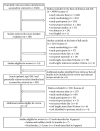Short tools to assess young children's dietary intake: a systematic review focusing on application to dietary index research
- PMID: 24198966
- PMCID: PMC3807550
- DOI: 10.1155/2013/709626
Short tools to assess young children's dietary intake: a systematic review focusing on application to dietary index research
Abstract
Dietary indices evaluate diet quality, usually based on current dietary guidelines. Indices can therefore contribute to our understanding of early-life obesity-risk dietary behaviours. Yet indices are commonly applied to dietary data collected by onerous methods (e.g., recalls or records). Short dietary assessment instruments are an attractive alternative to collect data from which to derive an index score. A systematic review of studies published before April 2013 was conducted to identify short (≤50 items) tools that measure whole-of-diet intake of young children (birth-five years) and are applicable to dietary indices, in particular screening obesogenic dietary behaviours. The search identified 3686 papers of which 16, reporting on 15 tools (n = 7, infants and toddlers birth-24 months; n = 8, preschoolers 2-5 years), met the inclusion criteria. Most tools were food frequency questionnaires (n = 14), with one innovative dietary questionnaire identified. Seven were tested for validity or reliability, and one was tested for both. Six tools (n = 2, infants and toddlers; n = 4, preschoolers) are applicable for use with current dietary indices, five of which screen obesogenic dietary behaviours. Given the limited number of brief, valid and reliable dietary assessment tools for young children to which an index can be applied, future short tool development is warranted, particularly for screening obesogenic dietary behaviours.
Figures
References
-
- Kant AK. Dietary patterns and health outcomes. Journal of the American Dietetic Association. 2004;104(4):615–635. - PubMed
-
- Hu FB. Dietary pattern analysis: a new direction in nutritional epidemiology. Current Opinion in Lipidology. 2002;13(1):3–9. - PubMed
-
- Newby PK, Tucker KL. Empirically derived eating patterns using factor or cluster analysis: a review. Nutrition Reviews. 2004;62(5):177–203. - PubMed
-
- WHO. Obesity and overweight. World Health Organization (WHO), 2011, http://www.who.int/mediacentre/factsheets/fs311/en/
-
- Craigie AM, Lake AA, Kelly SA, Adamson AJ, Mathers JC. Tracking of obesity-related behaviours from childhood to adulthood: a systematic review. Maturitas. 2010;70(3):266–284. - PubMed
Publication types
MeSH terms
LinkOut - more resources
Full Text Sources
Other Literature Sources
Miscellaneous


